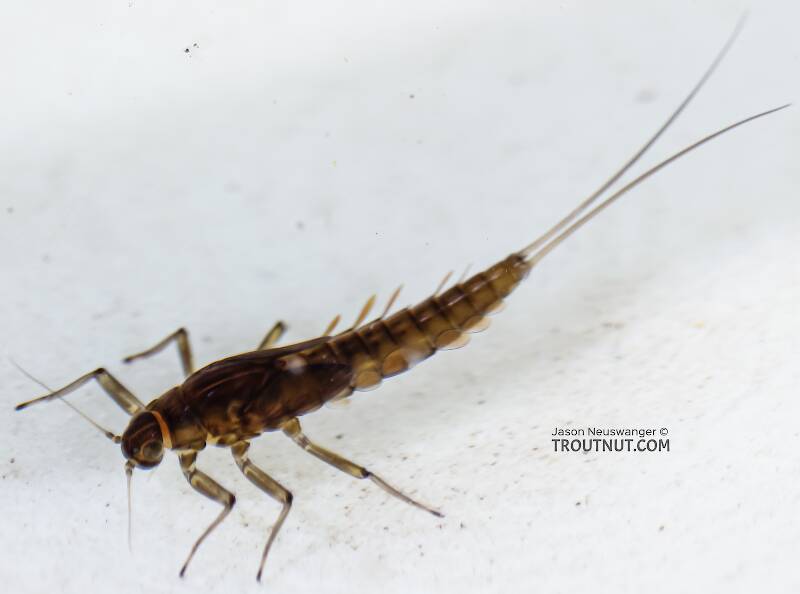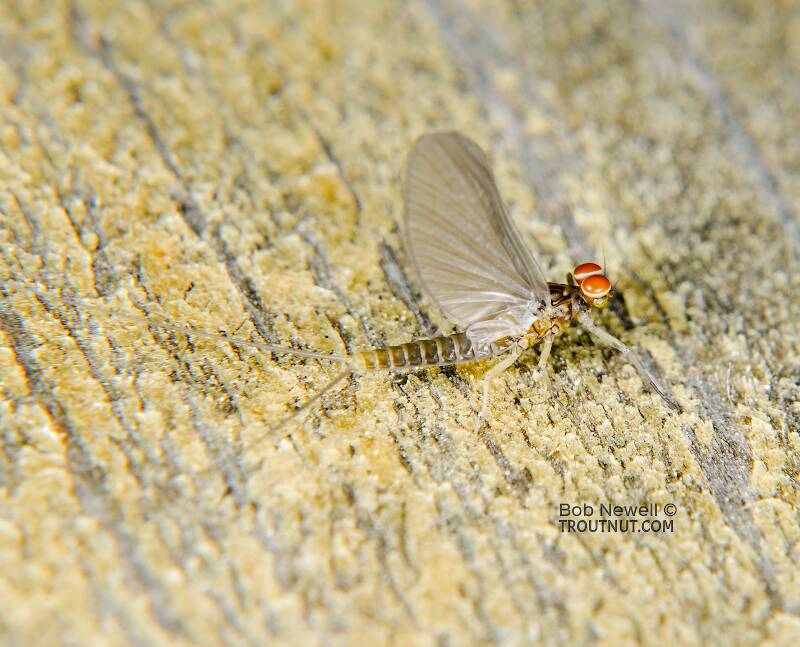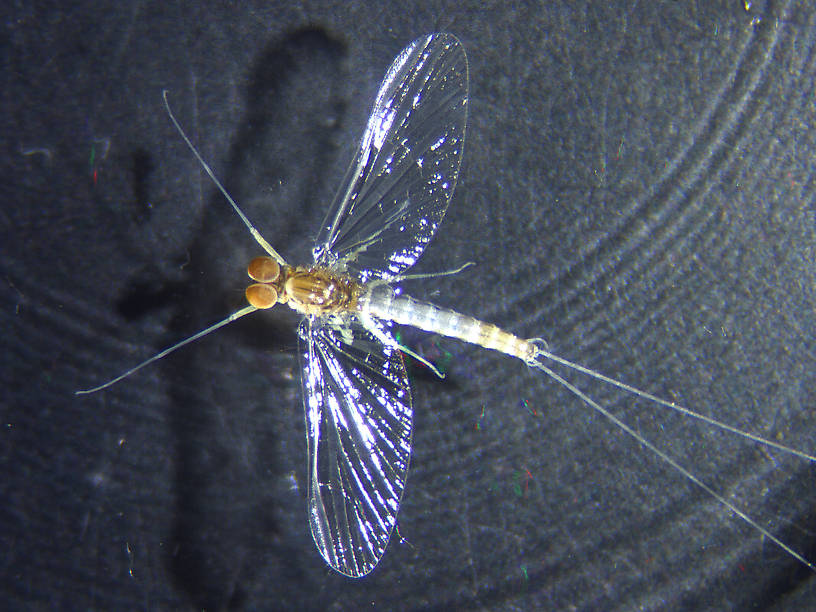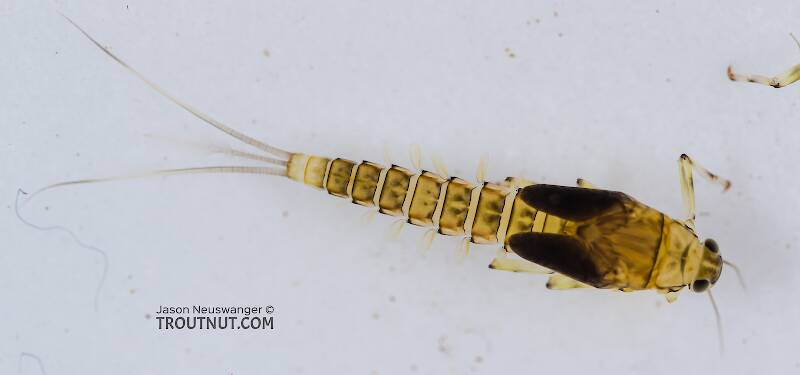
Hex Mayflies
Hexagenia limbata
The famous nocturnal Hex hatch of the Midwest (and a few other lucky locations) stirs to the surface mythically large brown trout that only touch streamers for the rest of the year.
Featured on the forum

It's only barely visible in one of my pictures, but I confirmed under the microscope that this one has a prosternal horn and the antennae are mid-way between the eyes and front of the head capsule.
I'm calling this one Pycnopsyche, but it's a bit perplexing. It seems to key definitively to at least Couplet 8 of the Key to Genera of Limnephilidae Larvae. That narrows it down to three genera, and the case seems wrong for the other two. The case looks right for Pycnopsyche, and it fits one of the key characteristics: "Abdominal sternum II without chloride epithelium and abdominal segment IX with only single seta on each side of dorsal sclerite." However, the characteristic "metanotal sa1 sclerites not fused, although often contiguous" does not seem to fit well. Those sclerites sure look fused to me, although I can make out a thin groove in the touching halves in the anterior half under the microscope. Perhaps this is a regional variation.
The only species of Pycnopsyche documented in Washington state is Pycnopsyche guttifera, and the colors and markings around the head of this specimen seem to match very well a specimen of that species from Massachusetts on Bugguide. So I am placing it in that species for now.
Whatever species this is, I photographed another specimen of seemingly the same species from the same spot a couple months later.
I'm calling this one Pycnopsyche, but it's a bit perplexing. It seems to key definitively to at least Couplet 8 of the Key to Genera of Limnephilidae Larvae. That narrows it down to three genera, and the case seems wrong for the other two. The case looks right for Pycnopsyche, and it fits one of the key characteristics: "Abdominal sternum II without chloride epithelium and abdominal segment IX with only single seta on each side of dorsal sclerite." However, the characteristic "metanotal sa1 sclerites not fused, although often contiguous" does not seem to fit well. Those sclerites sure look fused to me, although I can make out a thin groove in the touching halves in the anterior half under the microscope. Perhaps this is a regional variation.
The only species of Pycnopsyche documented in Washington state is Pycnopsyche guttifera, and the colors and markings around the head of this specimen seem to match very well a specimen of that species from Massachusetts on Bugguide. So I am placing it in that species for now.
Whatever species this is, I photographed another specimen of seemingly the same species from the same spot a couple months later.

Troutnut is a project started in 2003 by salmonid ecologist Jason "Troutnut" Neuswanger to help anglers and
fly tyers unabashedly embrace the entomological side of the sport. Learn more about Troutnut or
support the project for an enhanced experience here.
Light Rusty Spinners
Like most common names,"Light Rusty Spinner" can refer to more than one taxon. They're previewed below, along with 4 specimens. For more detail click through to the scientific names.
Mayfly Species Baetis bicaudatus
These are very rarely called Light Rusty Spinners.
Baetis bicaudatus is a western taxon of some local importance.

Here I'm just copying and pasting, without cleaning up, my notes from spending a long time with this one under the microscope (and keying with Merritt & Cummins 5th Ed) only to end up confirming the most likely guess.
7. Baetis bicaudatus nymph
1. Hind wingpad present but small and hidden beneath forewing pad
2. Segment 2 of labial palp with well-developed medially projecting corner --> Baetis (couple 44). BUT no sign of scale-like setae on abdominal terga. Conflicts at this couplet.
3. Gills on segments I-VII
4. Tarsal claws with denticles, seemingly 2 rows but very hard to tell… and the key options with 2 rows don’t make sense
5. Assuming no villipore, we land confidently at couplet 48
6. Leads to Fallceon, except antennal scape doesn't have robust setae
7. Treated as Baetis, leads to brunneicolor, but McDunnough et al 1932 (Can Ent 64) suggests middle tail should be 5/6 as long as outer ones
8. Keys VERY confidently to couplet 36 in M&C (villipore)
9. If assuming villipore present:
1. 37 --> Scape of antennae has no distal lobe --> rules out Labiobaetis (100 % certain)
2. 38 --> Terminal filament much shorter than cerci --> not Barbaetis benfieldi (100 % certain)
3. 39 --> Terminal filament reduced (100 % certain)
4. 40 --> Tarsal claw denticle count couplet. If two rows of denticles: Either Iswaeon or Heterocloeon. Can't be Iswaeon because cerci lack dark median band. Can't be heterocloeon because it's not in the Platte drainage or in Texas. Thus, it must be one row of denticles. Moving on to 42.
5. 42 --> Hind wing pads present (100 % certain)
6. 44 --> Segment 2 of labial palpi with well-developed medially projecting corner (80 % certain), scale-like setae not evident on terga but maybe limitation of my scope --> Baetis (alternative would be Acentrella, but pronotum shape is all wrong for those, although not an official characteristic)
7. CONFIDENT in Baetis bicaudatus after distinctive leg markings (J-shaped light mark on first femur, L-shaped on second and third) matches original species description to a tee.
7. Baetis bicaudatus nymph
1. Hind wingpad present but small and hidden beneath forewing pad
2. Segment 2 of labial palp with well-developed medially projecting corner --> Baetis (couple 44). BUT no sign of scale-like setae on abdominal terga. Conflicts at this couplet.
3. Gills on segments I-VII
4. Tarsal claws with denticles, seemingly 2 rows but very hard to tell… and the key options with 2 rows don’t make sense
5. Assuming no villipore, we land confidently at couplet 48
6. Leads to Fallceon, except antennal scape doesn't have robust setae
7. Treated as Baetis, leads to brunneicolor, but McDunnough et al 1932 (Can Ent 64) suggests middle tail should be 5/6 as long as outer ones
8. Keys VERY confidently to couplet 36 in M&C (villipore)
9. If assuming villipore present:
1. 37 --> Scape of antennae has no distal lobe --> rules out Labiobaetis (100 % certain)
2. 38 --> Terminal filament much shorter than cerci --> not Barbaetis benfieldi (100 % certain)
3. 39 --> Terminal filament reduced (100 % certain)
4. 40 --> Tarsal claw denticle count couplet. If two rows of denticles: Either Iswaeon or Heterocloeon. Can't be Iswaeon because cerci lack dark median band. Can't be heterocloeon because it's not in the Platte drainage or in Texas. Thus, it must be one row of denticles. Moving on to 42.
5. 42 --> Hind wing pads present (100 % certain)
6. 44 --> Segment 2 of labial palpi with well-developed medially projecting corner (80 % certain), scale-like setae not evident on terga but maybe limitation of my scope --> Baetis (alternative would be Acentrella, but pronotum shape is all wrong for those, although not an official characteristic)
7. CONFIDENT in Baetis bicaudatus after distinctive leg markings (J-shaped light mark on first femur, L-shaped on second and third) matches original species description to a tee.
See 5 more specimens...
Mayfly Species Baetis tricaudatus
These are very rarely called Light Rusty Spinners.
Baetis tricaudatus is undeniably the most widespread and abundant baetid on the continent and arguably the most important mayfly species to trout and anglers alike. Eastern anglers used to know these important mayflies by the storied name of Baetis vagans. Conversely, the usually much larger and late Fall hatching brood of Baetis tricaudatus was considered an important Western species with its own tradition. But, entomologists recently determined that they are both in fact the same species. The nomenclature conventions guiding entomologists do not account for a name's regional fame among fishermen, and new or obscure species names may replace their old favorites. Sometimes taxa with disparate traditions are combined. Baetis vagans is one such casualty. Fortunately, trout think like Shakespeare: A rose by any other name would smell as sweet. The rose that was vagans has lost none of its charm. This species is multibrooded with the hatches of Spring being larger flies. As the weather warms the following broods are composed of progressively smaller flies. In the East, they range in size from 16 to 20. In the West, they may run a size larger.
See 10 more specimens...




